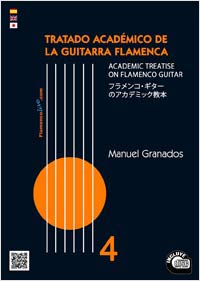I. LA TÉCNICA
1. ARPEGIOS LARGOS ABARCANDO LAS SEIS CUERDAS- Estudios de arpegios largos
2. TRÉMOLO FLAMENCO – Estudios de trémolo flamenco
3. PULGAR – Estudios de pulgar
4. ALZAPÚA – Estudios de alzapúa
5. PICADOS – Estudios de picados
6. ARPEGIO-PICADO – Fórmulas mecánicas 1 a 9 Estudio de arpegio-picado
7. ACORDES – Estudio
II. LOS ESTILOS
RONDEÑA Afinación característica Variaciones 1 y 2
MINERA Variaciones 1 y 2
FARRUCA Variaciones 1 a 4
SOLEÁ EN LA Variaciones 1 a 4
SERRANA Variaciones 1 a 3
III. LA TEORÍA MUSICAL DEL FLAMENCO
LA NOTA SENSIBLE DEL MODO FLAMENCO Y LA SENSIBLE TRANSITORIA
LA CADENCIA DEL MODO FLAMENCO
LA AMPLIACIÓN DE LA FUNCIÓN EN LA ARMONÍA DEL FLAMENCO EMPLEO DE LA SUBDOMINANTE DE UN TONO TRANSITORIO EN LA PROGRESIÓN
LA NOTA MI. PEDAL EN LAS PROGRESIONES ARMÓNICAS
R ELACIÓN Y FORMACIÓN DE LOS MODOS FLAMENCOS CARACTERÍSTICOS
Formato A4
72 páginas
Español, Inglés y Japonés.
Cifrado y nota
Ejemplo Soleá : Partitura – audio
Ejemplo Serrana : Partitura – audio
